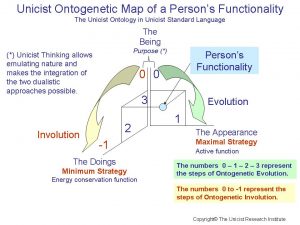The unicist ontology defines the nature of entities. It defines their purpose, their active function and their energy conservation function. These three elements are integrated in their oneness following the complementation and supplementation laws.
 It is a structural functionalist approach that belongs to the field of complexity science and emulates the ontogenetic intelligence of nature.
It is a structural functionalist approach that belongs to the field of complexity science and emulates the ontogenetic intelligence of nature.
An example is the unicist ontology of a person. The apprehension of this entity is based on:
1) The active function, the appearances, can be observed.
2) The energy conservation function, the doings, can be perceived.
3) The purpose, the being, needs to be intuited.
4) Their integration in their oneness requires using double dialectical thinking within a reflection process.
Some of these concepts are counterintuitive for adults. For example that appearance is an active function and that doings cannot be observed but only perceived. That is why humbleness and experiencing reality is basic to avoid conflicts with counterintuitive concepts.
To apprehend the nature of an entity it is necessary to have a preexisting sound knowledge, having experienced it to start a reflection process. The final step is the development of the necessary destructive and non-destructive tests until the definition has demonstrated that it suffices to forecast the evolution of the entity.
Access the content of the book “The Ontogenesis of Evolution: The Unicist Ontology of Evolution” at the Unicist Library: http://www.unicist.com/books-pages/en/unicist_ontology_evolution_en3s.php
NOTE: The Unicist Research Institute was the pioneer in complexity science research and became a global decentralized world-class research organization in the field of human adaptive systems.
https://www.unicist-school.org/theoryofevolution/wp-content/uploads/2012/06/turi.pdf